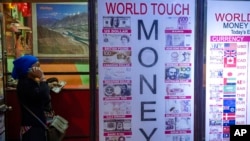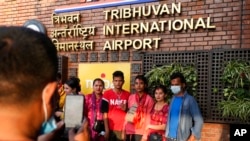Nepal has banned imports of cars, alcohol and other luxury goods to conserve foreign exchange reserves as spiraling prices of fuel and food imports stemming from the war in Ukraine strain an economy already battered by the COVID-19 pandemic.
The Himalayan nation between India and China is the second South Asian country, after Sri Lanka, to face a foreign exchange crunch.
The goods that will not be imported include expensive televisions and mobile phones, the government said this week. The ban will remain in force until mid-July.
To conserve fuel, which Nepal imports, the work week in government offices has been shortened to five days.
"This is a short-term measure taken to prevent the economic condition of the country from going bad," said Narayan Prasad Regmi, a senior official in the Industry, Commerce and Supplies Ministry.
Nepal’s central bank has said foreign exchange reserves are sufficient to cover just over six months of imports, down from 10 months in mid-2021. The landlocked nation of 29 million is heavily dependent on imports.
The government hopes the measures will help stave off a crisis like the one roiling Sri Lanka, where acute foreign exchange shortages have resulted in massive supply shortfalls, runaway price increases of fuel and food and a suspension of payments of its foreign debt.
Experts however call Nepal’s temporary ban on luxury goods and the shortening of the work week “desperate measures” that will not address the root cause of the problem that the economy faces.
“All this is only a quick fix and a Band-Aid over essentially what is a very big crack. The basic problem is that our imports far exceed our exports, so we face a huge balance of payments problem,” according to Santosh Sharma Poudel, co-founder of Nepal Institute for Policy Research.
Nepal’s foreign exchange crunch began during the COVID-19 pandemic. With tourism hit, earnings from foreign visitors plummeted in a country where more than a million tourists used to come before the pandemic.
Remittances sent by an estimated 3 million to 4 million Nepali migrants employed mostly in the Middle East and India have also taken a hit – before the pandemic they added up to as much as one-fourth of the country’s gross domestic product.
The war in Ukraine has added to its woes, as prices of both crude oil and food spiral in global markets -- Nepal’s imports most of its essential needs, such as fuel, and food, such as cooking oil.
While Nepal’s economy is not as fragile as Sri Lanka’s, there is apprehension of what lies in store in one of the world’s poorest nations. The World Bank warned this week that the war in Ukraine is set to cause the "largest commodity shock" since the 1970s and "households across the world are feeling the cost-of-living crisis."
They are households like that of Vijay Thapa, who works as a cook in New Delhi to support his family in a village in Nepal. “They can no longer manage in what I send. Prices of everything have spiked, whether it is cooking oil or wheat. Taxi fares have gone up by 50%.”
The situation is more worrisome for small countries, experts say.
“This is the second example in South Asia of how the war just after the pandemic is affecting us,” said Dhanajay Tripathi, a professor at the South Asian University in New Delhi.
“There are real worries for countries like Nepal because with smaller incomes it is harder for them to absorb the shock of high imports compared to larger countries such as India where the huge economy makes it possible to manage,” he said.
Analysts also warn that fixing the economy could be more difficult because Nepal also has some of the political problems that contributed to Sri Lanka’s crisis.
“We also have crony capitalism; corruption is high and there is political instability. That makes it harder to put long-term efficient policies in place,” Poudel said.
Economic mismanagement that led to the crisis in Sri Lanka has been blamed on the powerful Rajapaksa political dynasty that controls the government. Although some family members have resigned as ministers, President Gotabaya Rajapaksa and his brother Mahinda, who is prime minister, still hold the top posts.
In Nepal constant infighting among political parties has resulted in short-lived governments for the last three decades. For much of last year, the country was mired in political turmoil and is presently ruled by a fragile five-party coalition.
Plummeting COVID-19 cases, though, have encouraged the country to lift restrictions on tourists. Tourism earnings are up, although still far below prepandemic levels. And as Middle East countries increase crude output after the pandemic, when demand had plunged, jobs are coming back for Nepalese nationals, which could mean remittances will again pick up.










